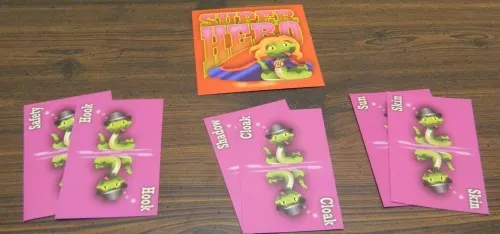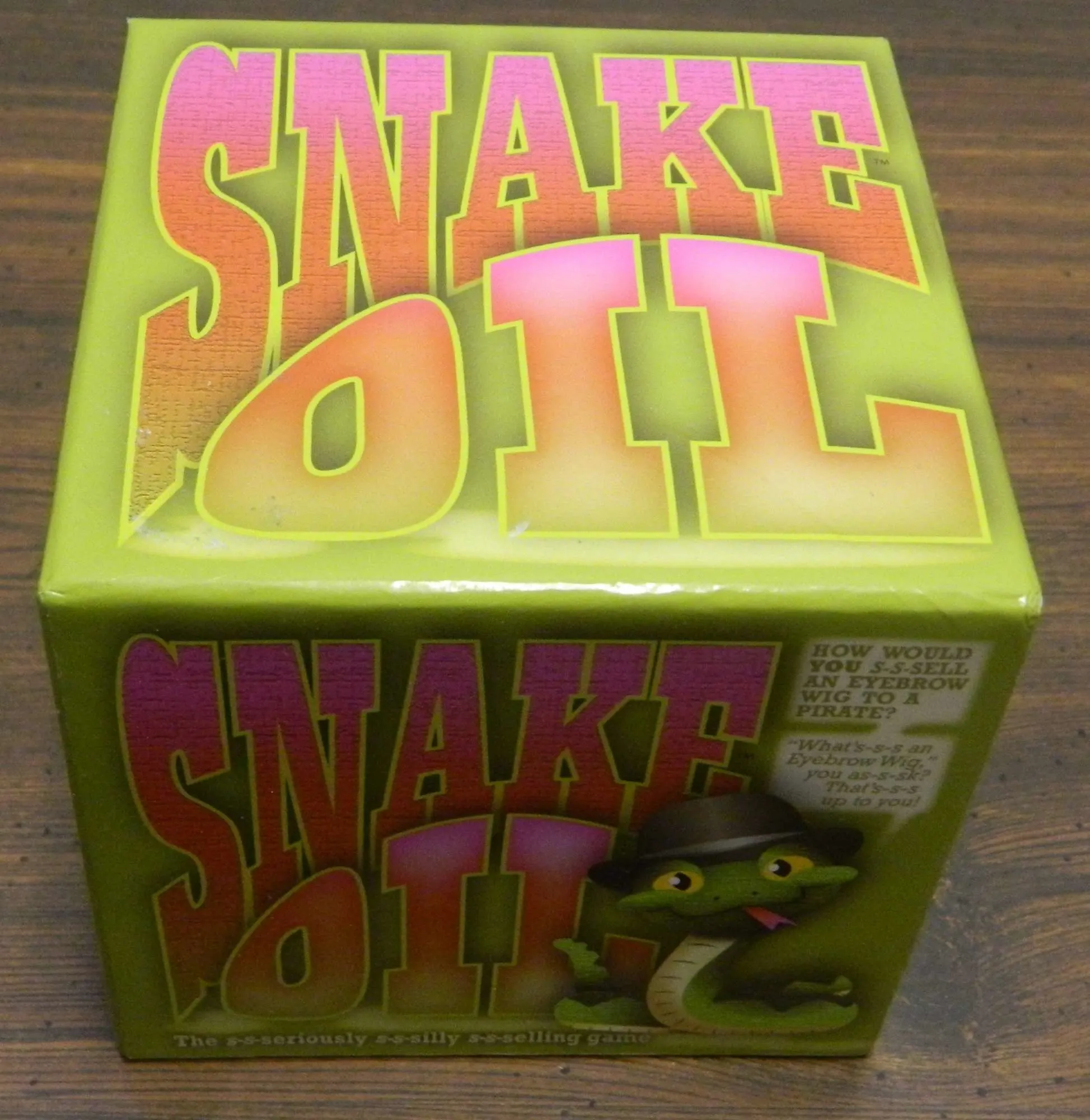How to Play
Objective
At the end of the game, acquire the most customer cards.
Setup
Each player is dealt six word cards. The players decide who will be the customer in the first round.
Round
To begin each round the current customer draws one of the customer cards to determine what type of customer they are going to be for the round. They read the card aloud and turn it face up so all players can see what type of customer the player is.
After the customer card is revealed players have 30-40 seconds to combine two cards from their hand to create a product that they think the customer will want. After everyone has created their product, each player makes a 30 second pitch to the customer on why they should purchase their product.

The customer for the current round is a superhero. The three players submitted their products which include a safety hook, a shadow cloak, and sun skin. The player that is the current customer decides which product a superhero is most likely going to want.
After all of the pitches have been heard, the player who is currently the customer decides which item they think their customer would be most likely to buy/enjoy. The player whose product was chosen gets to keep the customer card which indicates that they have scored a point in the game. All word cards used are discarded and each player who played cards during the round draws two new cards to get back up to six cards in their hand. The player to the left of the current customer becomes the customer for the next round.
Game End
After all of the players have been the customer for one round, the game ends. Players count up how many customer cards they acquired during the game. The player who acquired the most cards wins the game. If two or more players are tied, all of the tied players compete in another round and the player whose product is chosen wins the game.

It’s the end of the game. One player got two customer cards while two players got one customer card. The player who got two customer cards won the game.
Review
We at Geeky Hobbies are big fans of the Apples to Apples genre of games that have been prevalent in recent years. Basically in these type of games one player is the judge while the other players play cards that match a card that was drawn by the judge. Players try to play a card that best matches the card drawn by the judge or try to be the funniest in order to appeal to the judge’s sense of humor. I have played quite a few of these type of games in the past and while I have liked almost all of them, some of them are better than others. This brings us to Snake Oil. What makes Snake Oil stand out among these other games is that each player uses cards from their hand in order to create a product that they will then try to pitch to the judge. This concept really appealed to me and I was excited to try out the game. While not as good as Apples to Apples, Snake Oil is still a very good game.
Before getting too deep into the review I would like to point out that the version of Snake Oil that I used to play the game is actually the self published version of the game. Before the game was produced by Out of the Box the game was self published and the copy of the game that I found at the thrift store was actually that version of the game. The game appears to be exactly the same as the Out of the Box version though outside of some of the cards likely being different. The self published version of the game has some more adult themed cards (nothing too bad) which I am assuming were removed for the more family friendly Out of the Box version of Snake Oil.
Like most of these types of games Snake Oil is a party type game that should still work pretty well for children. I would probably not play the game with children under like age ten since it might be a little hard for younger children to devise a product using two of their cards and then try to pitch it to the customer.
I think if your group generally likes games like Apples to Apples they should like Snake Oil. While Snake Oil is a good game it is probably not going to be for everyone. The game thrives on the players being creative and coming up with creative ways to use their cards. If you have a group of creative people the game will truly shine and you will probably get a lot of laughs out of the game. If your group is not in the right mood or isn’t very creative though the game could get dull pretty quickly.
The biggest problem that I have with these Apples to Apples style games is that there is the possibility that players will get stuck in a situation where they really don’t have any cards that work for the current situation. Unfortunately in Snake Oil this seems like a bigger issue than with most of these type of games. The main reason that this issue seems kind of prevalent in the game is the fact that you need two cards that work well together. Too often there are situations where you don’t have two cards that work together at all. Some rounds you pretty much have to just play two random cards just to get them out of your hand. While increasing hand sizes will fix some of these problems, there are still too many situations when players have no good options for creating a product. This problem is made worse when you get a round where none of the players are able to create a good product for the customer and the judge pretty much just has to randomly pick a product. Since I got the self published version of the game there is a chance some of these issues were corrected with the Out of the Box version but this is still likely to be the biggest problem with Snake Oil.
One idea our group came up with that might have helped with this problem would have been to separate the word cards into a couple different types of cards which would be indicated by different colored backs. One color could be nouns while another color could be adjectives and so on. Players could then choose what types of cards they wanted to take to fill up their hand which would give players better options while also letting them have more control over their fate in the game.
Just like with all of these type of games, the scoring system in Snake Oil is not the greatest. Usually these games are played more for the experience than actually determining the winner. If you want a game where there is a definite winner, Snake Oil is not going to be it. If any of the players are really competitive the game can actually suffer quite a bit since a player could rig their turn as judge by purposely not giving a customer card to a player that is in first even if that player deserved it. Adding in the fact that there are many instances where the cards in a player’s hand just don’t work well together and I think it would be best if you just ditched the scoring element of the game altogether.
Having played many of these Apples to Apples style games I knew one of the rules for Snake Oil was going to be an issue so our group decided to ditch it immediately. Except for very large groups I just don’t see the point of the rule where every player is only the customer once. Unless you have eight or more players this will just make the game way too short. For example if you only have four players you could probably finish the game in around ten minutes. That is just way too short so my group just plays until everyone is sick of the game and we count up who got the most customer cards. I would highly recommend playing the game in this manner unless you are playing with a bunch of players. Ditching this rule is also beneficial since it allows you to adjust the game to any length that you want. If you want to play for 10-20 minutes play by the normal game rules. If you want to play for an hour just play until the hour has passed.
Speaking of house rules I have to bring up the random player rule that my group always adds to these type of games. One time while playing Apples to Apples we decided to create a rule where a random card was added to the choices just to see how it would work. Since it was a success we have since continued to use this house rule when playing these type of games. In Snake Oil we randomly drew two cards from the draw pile in order to create a random product for each round. While it didn’t work as well as it does in other games, the random product was actually sometimes the best option for a given round. The random customer actually won several rounds. Then there were the rounds where the random product gave us great products such as “poop tape”. Not surprisingly that round was not one of the rounds that the random product won.
While the components might differ some from the Out of the Box version of the game, for the most part the cards are really well done. The artwork on the customer cards in particular are really well done. I just love how the game finds a way to illustrate all of the different customers using their trademark snake character. The word cards are nothing special to look at but are designed in a way making them easy to read. While the word selection could have been better and I wish the game came with more cards, I really don’t have any complaints about the cards.
Final Verdict
While Snake Oil plays a lot like Apples to Apples, it is still a good game. It is probably not as good as Apples to Apples and some of the other games of the same style but it is still a fun game that I would recommend to fans of these type of games. The one reason that I would say that Snake Oil is worse than some of the other games from the genre is that it is harder to actually find good uses for your cards. Too often there will be situations where your submission makes no sense as you just try to get rid of some of your cards. Other than this issue though the game is really fun and the mechanic of you trying to pitch your product is a good addition to the traditional Apples to Apples formula.
If you have tried games like Apples to Apples before and didn’t really care for them you probably won’t like Snake Oil either. If you like these type of games though I think you will really like Snake Oil.
If you would like to purchase Snake Oil you can purchase it on Amazon here.

